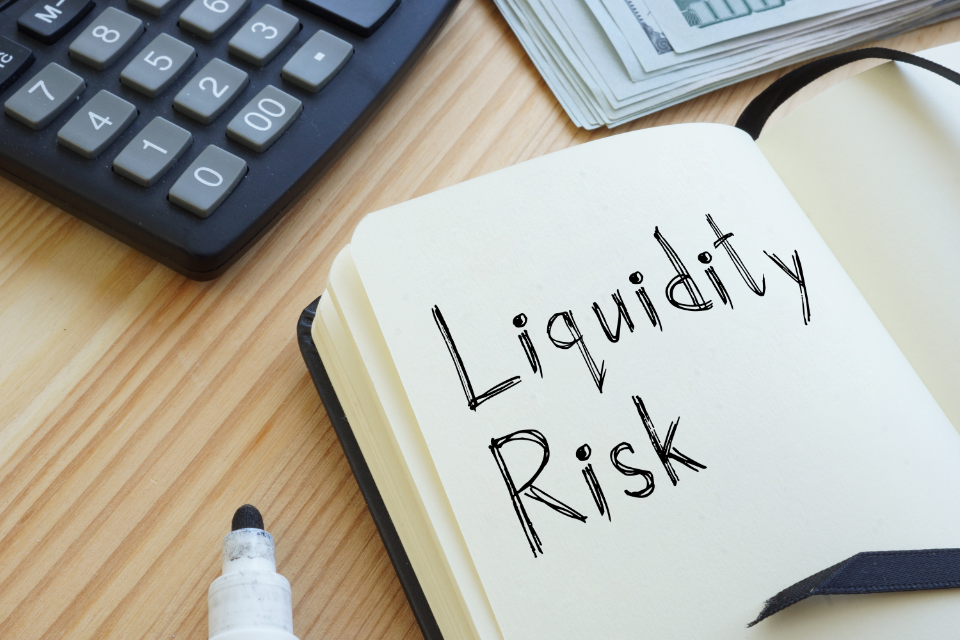Before we get into the jargon, liquidity risk in colloquial terms refers to a company or individual's inability or lack of capacity to meet any financial commitment within a said period. The risk part refers to the threat of incurring losses and suffering other consequences due to the shortage of funding.
Let's understand a nuanced version of this definition and get into some common queries related to liquidity risk.
What is Liquidity?
When measuring the level of risk within an organization, investors and executives employ metric ratios of uncertainty. They frequently compare short-term liabilities to the liquid assets disclosed on its financial statements.
If a company's liquidity risk is excessive, it must sell assets, create additional revenue, or find another strategy to close the available cash and debt gap.
Market liquidity, which relates to investments and assets, and accounting liquidity, which applies to a company or personal accounts, are the two types of liquidity.
Liquidity is crucial since it demonstrates its ability to satisfy its financial obligations and unforeseen expenses. It is also applicable to the typical person. Their financial status improves as their liquid assets (cash savings and investment portfolio) outnumber their debts.
Liquidity measurement can provide insight into how your firm is functioning financially right now and help you plan for the future.
When it comes to liquidity planning, you'll search for instances when you'll have extra cash that you can put toward other investments or growth prospects.
To do liquidity planning, use the same current, quick, and cash ratios we discussed earlier in this article to assess financial health in future situations. You can read further details about liquidity here.
Define: Liquidity Risk
Liquidity refers to a company's or an individual's capacity to pay its debts without incurring significant losses. Liquidity risk stems from an investment's inability to acquire or sell quickly enough to avoid or reduce a loss. It frequently manifests itself in extensive bid-ask spreads or big price swings.
The consensus is that the smaller the securities or issuer, the greater the liquidity risk. Following the 9/11 attacks and during the 2007–2008 global credit crisis, drops in the value of stocks and other securities prompted many investors to sell their holdings at any price. The rush exacerbated market illiquidity to the exits, which resulted in widening bid-ask gaps and substantial price drops.
When an individual investor, corporation, or financial institution cannot satisfy its short-term loan obligations, liquidity risk arises. Due to a shortage of buyers or an inefficient market, the investor or business may be inadequate to convert an asset into cash without sacrificing capital and revenue.
Simply expressed, liquidity risk is the risk that a company may not have enough cash on hand to satisfy its financial obligations on time. A business will experience a liquidity crisis and eventually become insolvent if it lacks effective cash flow management and sound liquidity risk management.
Businesses must be on the lookout for typical causes of liquidity risk as they go about monitoring and controlling it. Companies and investors can use liquidity risk to assist them in managing their investments, assets, and activities to meet their financial obligations consistently. They might buy assets that they can't sell without losing money or causing other financial problems if they don't have this information.
What are the Sources of Liquidity Risk?
Scarcity of cash flow management
Cash flow management allows a company to see possible liquidity issues and possibilities. Cash is king, and cash flow is the lifeblood of every company. A business's exposure to needless liquidity risks will increase if cash flow is not managed correctly. Furthermore, a company that does not have a well-managed and robust cash flow would struggle to stay profitable, achieve advantageous financing terms, recruit potential inventors, and remain viable in the long run.
Inept to obtain financing
When it comes to obtaining finance, a history of late debt repayment and/or non-compliance with loan covenant terms may provide extra obstacles. As a result, firms must manage their capital structures well, match loan maturity profiles to assets, and regularly keep in touch with lenders. Liquidity risk is increased by the inability to access funding at all, let alone at competitive rates and terms.
Unnecessary Expenditure
Having proper fixed asset management is extremely important, particularly for a business that operates in a capital-intensive industry such as energy, telecommunications or transportation. A capital-intensive business is often highly leveraged with a high fixed to variable costs ratio. Single unplanned capital expenditures for businesses like these may exacerbate existing budget constraints, such as a new purchase or significant equipment repairs. This, in turn, further increases operating leverage and heightens liquidity risk.
Market Disruption
Market disruption can occur if a sharp drop in the stock market is fueled by investor fears that specific causes would generate widespread problems that will stymie business flow.
For example, if war threatens the safe operation of oil rigs in a vital industry zone, it may raise concerns regarding access to this resource. Intense hurricanes, other natural disasters or a pandemic like the COVID -19 scenario currently can also create significant disruptions if they strike in areas that are critical to an industry's operations and compel an indefinite halt to output.
Following the 1987 market crash, procedures such as circuit breakers and price controls were implemented to reduce the dangers of market disruptions. These systems are meant to cease trade in rapidly dropping markets to avert panic.
Measurement of liquidity risk
The approach for calculating liquidity risk differs depending on the type. We'll start with funding liquidity risk, which refers to the difference between the number of liquid assets a company has and the amount it owes.
So, cash and assets converted into cash are considered current assets within a year. Here are a few ways to analyze the situation:
Proper analysis of financial ratios is important. Financial ratio analysis, knowing what these ratios represent, and selecting the best course of action are all part of good liquidity management.
Financial ratios give a company current indicators of liquidity risk based on historical performance, allowing it to make the necessary financial and operational adjustments to assure desired future financial and operational outcomes.
Current Ratio
The Current Ratio is commonly used to assess liquidity risk. As defined by Current Obligations, the current ratio is the value of current or short-term liabilities. The ideal ratio is thought to be greater than 1, indicating that the company can pay its current creditors using short-term assets.
Current Ratio = Current Assets / Current Liabilities
From here, we can conclude that,
When Current Assets exceed Current Liabilities, the ratio is more significant than 1.0, which is good.
If Current Assets Equals Current Liabilities, the ratio is 1.0, indicating that Current Assets are insufficient to pay off short-term obligations.
If Current Assets are fewer than Current Liabilities, the ratio is less than 1.0, indicating that the company does not have enough cash to meet its short-term obligations.
Quick Ratio
The quick ratio measures a company's capacity to satisfy short-term obligations with its most liquid assets.
It's also known as the acid test ratio. It shows a company's ability to quickly pay down current liabilities using near-cash assets (assets that can be converted to cash quickly). An "acid test" is a slang phrase for a rapid test that yields immediate results.
Quick Ratio = (Cash + Accounts Receivables + Marketable Securities)/Current Liabilities
A company's quick ratio should ideally be more significant than one. If the ratio comes out less than one, the corporation can effectively satisfy its liabilities if they all become due simultaneously.
Liquidity ratio vs Quick Ratio
Liquidity ratios like current and quick ratios assess a company's capacity to satisfy its current debt obligations. The quick ratio solely considers quick or liquid assets in its calculation, whereas the current ratio considers all current assets.
The quick ratio, considered the more conservative ratio, only examines assets that can be converted into cash quickly. In contrast, the current ratio includes inventory, an asset that cannot be converted into cash in most situations within 90 days or less.
Although these two ratios appear to be very close at first look, the gap between the current and quick ratios is significant. As an investor, instead of getting caught up in the current ratio vs quick ratio debate, it's a better idea to utilize both ratios in tandem to establish a company's liquidity.
Measurement of Cash flow
The process of estimating business cash flow over a set period is known as cash flow forecasting.
A precise cash flow prediction aids businesses in predicting future financial positions, avoiding debilitating cash shortages, and maximizing profits on any cash surpluses.
Management of the Capital Structure
The amount of debt or equity utilized by a firm to fund operations and financial assets is called capital structure. A debt-to-equity or debt-to-capital ratio is commonly used to describe a company's financial structure. A company's operations, capital expenditures, acquisitions, and other investments are funded through debt and equity capital.
When deciding whether to finance operations with debt or equity, companies must compromise, and management must balance the two to establish the best capital structure. A corporation should seek to see if it has enough liquidity to pay its debt along with the principle and interest and compare its gearing ratios to those of its competitors to assess liquidity risk due to over-leverage.
One such gearing ratio is:
Debt-Equity Ratio:
The debt-to-equity (D/E) ratio is calculated by dividing its total liabilities by its shareholder equity. It is used to determine a company's financial leverage. In Corporate Finance, the D/E ratio is a crucial indicator to consider. It's a metric for how much a corporation relies on debt vs wholly-owned funds to fund its operations. In the event of a business down slide, it shows the ability of shareholder equity to pay down all outstanding debts.
Debt/Equity = Total Liabilities/Total Shareholders’ Equity
A larger debt-to-equity ratio indicates that a corporation is riskier to its stockholders, raising the likelihood of bankruptcy if business slows. It signifies that the company's expansion has been highly reliant on debt. While this can increase earnings and thus benefits shareholders, the cost of debt may outweigh incoming earnings, causing share prices to decline.
On the other hand, a low debt-to-equity ratio indicates that the company uses less debt financing from lenders and more equity funding from shareholders. A debt-to-equity ratio of less than 1.0 is generally regarded as healthy however this varies by industry. Generally, a score of less than 2.0 is preferable.
Management of liquidity risk
We aim to reduce our exposure to liquidity risk by managing the liquidity risk of the suppliers and minimizing the effects of liquidity risk. To begin, determine the sources of liquidity risk. Then create liquidity key risk indicators or measurements that allow you to quantify the level of risk associated with a specific activity.
We might analyze our suppliers' credit rating or profit margin, for example, when assessing their liquidity. To guarantee that they can satisfy their financial responsibilities, companies and individuals must consider liquidity risk while developing business plans, purchasing assets, or making investments.
They risk accruing late fines, acquiring additional money from high-interest loans, becoming insolvent, or going bankrupt if they do not take action.
The following methods are used to manage liquidity risks.
Estimation of Cash Flow
Estimating future revenues and expenses are part of cash flow forecasting.
A cash flow projection is an essential tool for your organization since it tells you if you'll have enough money to run it or expand it. It will also show you when the firm is losing more money than it brings in.
A solid cash flow projection will not only help firms avoid liquidity problems when unexpectedly large expenses arise, but it will also reconcile the two crucial financial features of cash flow and profit.
No matter how much money a company makes, if it can't turn it into cash, it won't be able to meet financial commitments like paying employees, buying merchandise, expanding liquidity, and avoiding insolvency.
Contrasting Assets and Liabilities
It is the act of controlling the use of assets and cash flows to limit the risk of a company losing money due to a failure to pay liability on time.
Assets and liabilities that are well-managed boost earnings. Asset/liability management is commonly used to manage bank loan portfolios and pension schemes. It also includes equity's economic value.
By comparing assets and liabilities, businesses can evaluate how much cash they could create on short notice and how much they would owe.
Conducting a Stress Assessment
Keeping in mind the financial institution's ability to meet obligations during moments of stress in the absence of market or funding liquidity by precisely evaluating the balance sheet's liquidity profile at an enterprise level.
In the case of an economic shock, simulations or other evaluations can help identify danger areas. Based on this knowledge, the organization or individual can build risk-mitigation methods and controls. With your supplier, go over the worst-case possibilities.
Liquidity risk drivers and risk areas to be aware of are revealed during stress testing. You become more prepared for a financial setback. Using this information, you and your suppliers can build procedures to limit these risks.
Illustrations of Liquidity Risk
- Inability to meet short-term debt obligations due to unusual losses or damages incurred during operations.
- Inability to secure adequate financing in time. There is a risk of break-even in most startup finance-based companies. As a result, if the business does not receive funding again, there is a danger of Liquidity risk.
- The increase in the material price leads to an increase in manufacturing costs for the company. Liquidity risk, for example, can result in a spike in commodity costs, which is unwelcome for a company that manufactures auto accessories.
Key Takeaways
- Liquidity is crucial since it demonstrates its ability to satisfy its financial obligations and unforeseen expenses
- Liquidity planning is the process of coordinating the expected receipt of bills and the expected sending of invoices through accounts receivable and accounts payable. The focus is on recognizing instances when you could be short on funds to cover projected expenses and figuring out how to deal with any deficits
- The threat to an institution's financial situation or safety and soundness posed by its inability (real or perceived) to meet its contractual obligations is known as liquidity risk
- The Current Ratio is one of the most used ways to assess liquidity risk
- Liquidity risk has emerged as one of the most critical components of an enterprise-wide risk management strategy. The liquidity framework should retain sufficient liquidity to resist all types of stressful situations
- When measuring the level of risk within an organization, investors and executives employ metric ratios of uncertainty. They frequently compare short-term liabilities to the liquid assets disclosed on its financial statements
- If a company's liquidity risk is excessive, it must sell assets, create additional revenue, or find another strategy to close the available cash and debt gap
Related Articles











